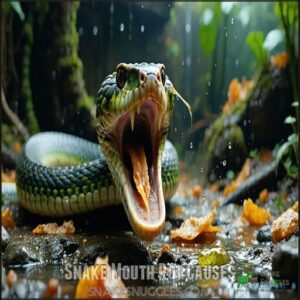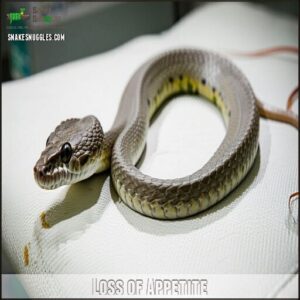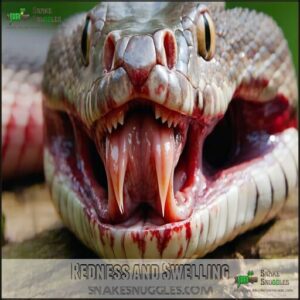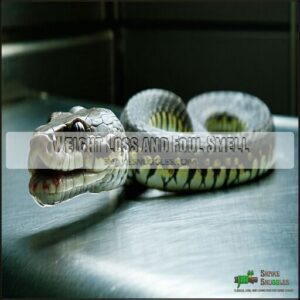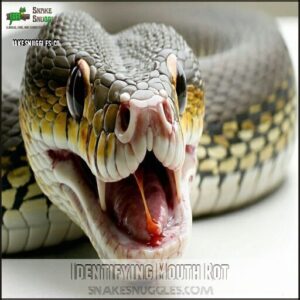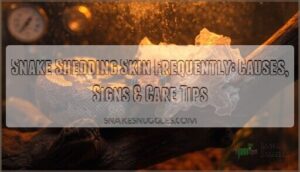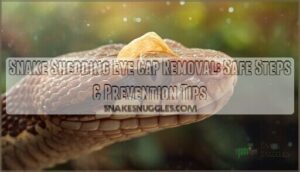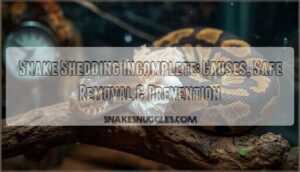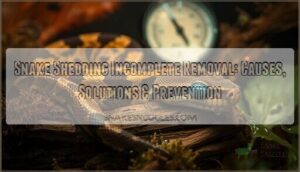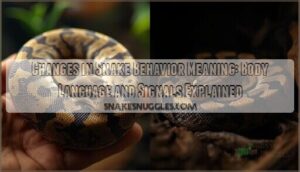This site is supported by our readers. We may earn a commission, at no cost to you, if you purchase through links.

Your snake might stop eating, drool more than usual, or have red, swollen gums. Blisters, sores, or pus around the mouth are also common signs, and you’ll often notice an unpleasant smell.
In severe cases, they might struggle to open their mouth or even lose teeth. You may also see weight loss or trouble breathing if the infection spreads.
Catching it early is vital, so keep an eye on these signs—it’s like being a detective for your snake’s health, and this can help prevent severe cases of infection.
Table Of Contents
- Key Takeaways
- Snake Mouth Rot Causes
- Common Symptoms Appear
- Advanced Symptoms Develop
- Identifying Mouth Rot
- Treatment and Prevention
- Frequently Asked Questions (FAQs)
- How do I know if my snake has mouth rot?
- How to cure mouth rot on a snake?
- Can I treat mouth rot at home?
- How long does mouth rot last?
- How quickly does snake mouth rot progress?
- Can snakes recover fully from mouth rot?
- What are common early signs owners miss?
- Are certain snake breeds more prone to this?
- What home care complements veterinary treatment?
- Conclusion
Key Takeaways
- Look for early signs like drooling, red or swollen gums, and loss of appetite to catch mouth rot before it worsens.
- Keep your snake’s enclosure clean, regulate humidity, and maintain proper temperatures to prevent infections.
- Avoid treating mouth rot at home—consult a reptile vet for proper diagnosis and treatment like antibiotics.
- Stress and poor hygiene are key causes, so reduce stressors and clean your snake’s habitat regularly to protect their health.
Snake Mouth Rot Causes
Snake mouth rot is caused by bacteria, fungi, or poor hygiene in the snake’s environment.
Bacteria, fungi, and poor hygiene create the perfect storm for snake mouth rot—stay vigilant to protect your reptile’s health.
Stress, injuries, or underlying health issues can weaken the immune system and make infections more likely.
Bacterial Infections
Bacterial infections are a top cause of snake mouth rot, often from Pseudomonas aeruginosa or Escherichia coli.
These sneaky bacterial strains exploit weaknesses, spreading systemically if untreated. Inadequate husbandry practices further exacerbate this risk.
Watch for these sources:
- Oral injuries from prey or enclosures.
- Poor hygiene in cages or water bowls.
- Stress weakening immunity.
- Secondary infections from other illnesses.
Attention to care prevents complications, and understanding these factors is key to maintaining the health of snakes and preventing the onset of snake mouth rot.
Fungal Infections
Fungal infections, like those caused by Aspergillus species, can worsen snake mouth rot symptoms.
These oral infections thrive when stress or poor care weakens immunity, giving fungi an edge over opportunistic bacteria.
Antifungal medications help treat these cases, but environmental control and preventative measures, including managing humidity and cleanliness, are key to avoiding secondary infections and keeping your snake healthier.
Poor Hygiene
Ever notice how dirty enclosures can lead to snake mouth rot symptoms?
Poor hygiene, like water contamination and bacteria buildup, creates the perfect storm for infections. Regular enclosure cleaning and strict hygiene protocols are essential.
Preventative cleaning avoids bacterial growth, keeping snakes safe. Prioritize sanitation to prevent snake hygiene issues—clean enclosures mean fewer risks and healthier reptiles, which is crucial for maintaining healthy reptiles.
Stress and Weakened Immune System
Stress plays a huge role in snake mouth rot.
Environmental stressors like poor husbandry factors, improper temperatures, or overcrowding weaken the immune system.
This immune suppression makes snakes vulnerable to infections.
Nutritional deficiencies only add to the problem.
By reducing snake stress and providing stable conditions, you protect their immune system and reduce the risk of mouth rot symptoms appearing, which is crucial for preventing mouth rot.
Underlying Health Conditions
When a snake’s immune system weakens, underlying health conditions can pave the way for snake mouth rot.
Parasite risks, viral infections, and coexisting diseases like cancer make recovery harder.
Nutritional deficiencies also compromise immunity, increasing susceptibility.
- Common underlying issues:
- Parasites weaken immune defenses.
- Nutritional deficiencies reduce resilience.
- Viral infections escalate risks.
- Coexisting diseases exacerbate infections.
- Cancer weakens immunity further, making it harder for the snake to recover from viral infections and parasite risks.
Common Symptoms Appear
When mouth rot starts, you’ll notice subtle changes like your snake refusing food or drooling excessively.
Refusing food and excessive drooling are early clues that your snake might be battling the onset of mouth rot.
Other early signs include redness, swelling, or small sores around the mouth that shouldn’t be ignored.
Loss of Appetite
A noticeable loss of appetite can signal snake mouth rot.
Causes of anorexia include pain or inflammation making eating difficult, leading to food refusal and weight decline.
Over time, nutritional impact affects overall health, creating digestive issues and worsening the condition.
Catching snake eating problems early prevents severe snake weight loss and guarantees quicker recovery from difficulty eating.
Excessive Salivation
Excessive salivation is a noticeable sign of snake mouth rot.
This buildup of saliva can signal changes in saliva composition, linked to oral discomfort and swallowing issues.
Left unchecked, it might lead to dehydration risk. It’s more than a mess—it’s a diagnostic significance, helping identify snake oral infection.
Watch for this in combination with other snake mouth rot symptoms, as it holds diagnostic value.
Redness and Swelling
Redness and swelling in snake mouth rot can signal inflammation severity and potential tissue damage.
You’ll usually notice these changes around their mouth or gums.
Watch for:
- Swelling location, often uneven.
- Color changes, from normal pink to red or purple.
- Increased sensitivity, assessed by your snake’s reaction.
- Pain symptoms like avoidance of handling.
Early detection guarantees better outcomes and is crucial for addressing potential tissue damage.
Blisters and Sores
Blisters and sores often show up early in snake mouth rot, appearing as small lesions inside or around the mouth.
These snake mouth lesions can vary in severity, sometimes oozing or looking red and swollen.
Pay attention to sore locations, as they’re usually near the gums or lips.
Prompt care helps the healing process and prevents worse issues.
Facial Asymmetry
Facial asymmetry happens when one side of the snake’s mouth looks different or swollen compared to the other.
This asymmetry can result from snake mouth rot, causing uneven swelling or deformity severity.
Diagnostic imaging helps determine the functional impact, like trouble eating.
A snake’s behavior, such as increased hiding or lethargy, can also be an early sign.
Address symptoms early with corrective options, like antibiotics, because left untreated, asymmetry causes serious damage to your snake’s health.
Advanced Symptoms Develop
As mouth rot progresses, more severe symptoms like difficulty opening the mouth, tooth loss, and discharge may appear.
These signs indicate the infection is worsening and require immediate attention to prevent further complications.
Difficulty Opening Mouth
When snake mouth rot progresses, difficulty opening the mouth becomes a serious problem.
Swollen mouth tissues, joint immobility, and jaw muscle atrophy often lead to oral pain and feeding implications.
Bone degradation and nerve damage may also contribute, making it tough for your snake to eat or even move its jaw.
Addressing snake mouth swelling promptly is essential to avoid further complications and ensure the snake can eat, which is crucial for its survival, and this requires immediate attention to prevent oral pain.
Tooth Loss and Pus Discharge
Loose teeth and pus-filled discharge often signal advanced snake mouth rot.
Tooth loss occurs when tissue necrosis weakens the jaw, making eating painful.
Watch for signs like:
- Snake mouth pus around gums or teeth.
- Foul-smelling discharge due to bacterial infection.
- Pain when opening the mouth or chewing.
- Dead tissue buildup needing surgical options.
Discharge analysis helps identify pathogens, guiding effective treatment.
Open-Mouth Breathing and Lethargy
Breathing difficulty, like open-mouth breathing, is a key sign of respiratory issues tied to advanced mouth rot.
It’s often paired with reduced activity or snake lethargy, where reptile seems drained of energy.
These behavioral changes signal bigger problems at play, and if you notice such symptoms, it’s time for immediate veterinary care to improve your snake’s prognosis.
Weight Loss and Foul Smell
Weight loss paired with a foul smell often signals advanced snake mouth rot.
As infections worsen, anorexia signs and muscle atrophy become evident, stemming from a prolonged loss of appetite.
Halitosis origins trace back to bacterial buildup, while the dehydration impact weakens the snake further.
Similar symptoms, such as crusty scales, can indicate other conditions.
Secondary infections can escalate, leaving your snake lethargic and struggling to combat the infection.
Respiratory Distress
Struggling with respiratory distress, your snake may show open-mouth breathing or keep its head elevated to ease lung function.
Look for nasal discharge or signs of pneumonia risk, as these indicate serious respiratory issues.
Breathing difficulty often means the infection has spread to lung involvement.
Don’t wait—consult a vet immediately to address potential snake respiratory issues and prevent worsening pneumonia.
Identifying Mouth Rot
To identify mouth rot in your snake, start by checking for visible signs like redness, swelling, or discharge around the mouth.
A veterinarian can confirm the diagnosis through physical exams, swabs, and lab tests like X-rays and cultures.
Veterinary Examination
When your snake’s symptoms point to mouth rot, a veterinarian’s physical exam is the starting point.
They’ll review your snake’s health history and conduct a careful physical inspection. Expect discharge analysis under a microscope, swabbing techniques to identify bacteria, and imaging options like X-rays for hidden issues.
Fecal testing helps detect parasites, aiding a differential diagnosis.
- Painful, inflamed mouth tissue
- Swollen jaw or facial changes
- Discharge from mouth or nose
- Visible sores, blisters, or redness
- Observed lethargy or weight loss
Physical Inspection and Swabbing
Inspecting your snake’s mouth might be intimidating, but it’s necessary.
A veterinarian performs an oral examination, evaluating redness, swelling, or discharge.
They’ll swab affected areas to collect samples for microscope examination or culture.
Proper sample handling guarantees accurate bacterial identification.
This method confirms infection and guides treatment effectively.
The process involves several key steps, which are outlined below.
| Step | Purpose | Outcome |
|---|---|---|
| Oral Examination | Spot visible symptoms | Identify swelling or discharge |
| Swab Collection | Gather infection data | Quality samples for testing |
| Discharge Analysis | Detect pathogens | Pinpoint bacteria or fungi |
The table summarizes the steps involved in diagnosing and treating a snake’s infection, from oral examination to discharge analysis, ensuring a comprehensive approach to identifying and addressing the issue.
Laboratory Analysis and X-Rays
Laboratory analysis and X-rays play a key role in diagnosing mouth rot.
Bacterial identification and fungal cultures from collected samples reveal pathogens causing the infection.
X-rays assess bone involvement and help determine the severity.
Imaging techniques also identify underlying issues beyond the mouth. Combining cytology, culture, and these tests guarantees a precise diagnosis, guiding effective treatment for your snake.
Cytology and Culture
To pinpoint a bacterial infection, cytology and culture methods are essential.
A vet collects a sample through swabbing, placing it on culture mediums to grow and identify pathogens. Fungal cultures may reveal additional culprits.
Diagnosis guides treatment, including antibiotic sensitivity testing to guarantee effective medicine.
This precise step targets infection, guaranteeing your snake gets proper care.
Treatment and Prevention
To treat mouth rot effectively, you’ll need to combine veterinary care, proper medications, and supportive home care.
Preventing it involves maintaining clean living conditions, a balanced diet, and regular health check-ups.
Antibiotic Therapy
To treat snake mouth rot, antibiotics are often used to target bacterial infections.
These include various forms based on severity:
- Topical Antibiotic Therapy: Creams like silver sulfadiazine for surface infections.
- Oral Antibiotics: Effective for deeper infections.
- Injectable Antibiotics: For advanced cases.
- Probiotics Support: Helps restore gut health during long treatment durations, reducing resistance risks.
Maintaining proper snake hygiene is also essential in preventing the condition.
Supportive Care and Hospitalization
To complement antibiotic treatment, supportive care like fluid therapy and nutritional support restores hydration and strength when snakes can’t eat.
Pain management reduces discomfort, while heat support helps healing.
In severe cases, hospitalization provides intensive care, including surgery and long-term monitoring.
These treatments may require specialized products for hydration, which are essential for stabilizing your snake and preventing mouth rot from spiraling out of control, through supportive care and proper pain management.
Addressing Environmental Issues
Improving your snake’s habitat reduces stress and limits infections like mouth rot.
Verify:
- Humidity Levels: Maintain ideal humidity to prevent low moisture issues.
- Temperature Gradients: Create warm and cool zones for comfort.
- Enclosure Size: Provide ample space to avoid overcrowding.
- Hiding Spaces: Add secure areas where snakes feel safe.
Regular enclosure cleaning can help prevent bacterial and fungal issues.
Clean water, proper temperatures, and adjustments keep snakes healthy.
Proper Nutrition and Hygiene
Keeping your snake’s environment clean and meeting its dietary requirements is key to preventing snake mouth rot.
Prioritize hygiene by ensuring enclosure cleaning is consistent and water quality is high. You can find a suitable enclosure cleaner online.
A balanced diet supports proper shedding and strengthens immunity. Consider supplementation needs if required.
Good snake nutrition and proper care lay the foundation for overall health and rot prevention.
Regular Veterinary Check-Ups
Regular vet checkups are essential for your snake’s health.
A proactive approach helps with early detection of mouth rot and other issues.
During snake checkups, a reptile vet can:
- Offer expert advice on preventative care.
- Conduct thorough health monitoring.
- Spot signs of illness early.
- Confirm proper enclosure conditions.
- Support long-term well-being.
Consider using products for snake wellness checks.
Regular veterinary checkups build lasting health.
Frequently Asked Questions (FAQs)
How do I know if my snake has mouth rot?
Think of it like a warning light on your car.
Look for loss of appetite, drooping, redness, swelling, discharge, or foul smell around your snake’s mouth.
These signs mean a vet visit is imperative.
How to cure mouth rot on a snake?
To cure snake mouth rot, consult a reptile vet immediately.
Treatment includes antibiotics, mouth cleaning, and addressing underlying issues like poor habitat conditions.
Avoid DIY fixes, as they can worsen the infection.
Can I treat mouth rot at home?
You shouldn’t treat mouth rot alone at home.
It’s essential to consult a reptile vet for proper diagnosis and care.
Without expert help, infections can worsen, risking your snake’s health and even its life.
How long does mouth rot last?
When it rains, it pours, but with mouth rot, recovery depends on treatment.
Catch it early, and it may clear within weeks.
Severe cases might linger months, requiring vet care, antibiotics, and improved husbandry.
How quickly does snake mouth rot progress?
Snake mouth rot can progress rapidly, especially if untreated.
Early signs like redness and drooling may worsen within days, leading to severe swelling, discharge, and tissue damage.
Immediate veterinary care is essential to prevent complications.
Can snakes recover fully from mouth rot?
With proper care, most snakes bounce back from mouth rot completely.
Early treatment, a clean habitat, and addressing any underlying issues are key.
Don’t delay—quick action guarantees your snake’s health and full recovery.
What are common early signs owners miss?
Sometimes the sneaky symptoms like mild redness or puffiness around the mouth, a slight lack of appetite, or extra drool slip under the radar.
They’re easy to miss but can hint at an early problem.
Are certain snake breeds more prone to this?
Pythons and boas are more prone to mouth rot due to their size and specific husbandry needs.
Poor enclosure conditions, like low humidity or unsanitary setups, increase risks—making proper care essential for these snakes.
What home care complements veterinary treatment?
Imagine wiping drool off your snake’s swollen mouth daily.
Keep the enclosure spotless, adjust humidity, and monitor temperatures.
Offer soft food if needed, reduce stress, and clean with veterinarian-approved solutions to aid healing.
Conclusion
Think of snake mouth rot symptoms as your snake’s way of waving a red flag for help.
Spotting issues like drooling, swollen gums, or sores early can save them from severe infection.
Maintain a clean environment, reduce stress, and provide proper care to keep them healthy.
If you notice signs, don’t hesitate—get a vet involved.
With quick action, effective treatment, and prevention, you’ll help your snake thrive and stay free from mouth rot troubles, which is crucial for their overall health.
- https://www.safarivet.com/care-topics/reptiles-and-amphibians/boa-and-python/
- https://ocvetmedcenter.com/news/stinky-snake-breath-takes-the-mouth-rot/
- https://dakotahillsveterinary.com/2013/12/15/mouth-rot-in-reptiles/
- https://vcahospitals.com/know-your-pet/snakes-diseases
- https://vethelpdirect.com/vetblog/2021/03/21/what-is-mouth-rot-in-snakes-and-why-does-it-occur/

